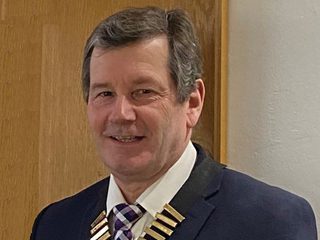
Institute News
Dear Members,
Welcome to the March-April issue of the Corrosion Management.
Since our January–February issue, two significant events have come to pass:
WCO – World Corrosion Awareness Day launched by the WCO in 2010 and International Women’s Day declared by
the United Nations in 1975.
International Women’s Day was observed with great enthusiasm all throughout the world on 8th March. Multimedia publications featured images and narratives showcasing the achievements of women. Many forums condemned the manner in which women are still oppressed and advocated for improvements to women’s rights. With continuing tales of women’s subjugation, my heart was heavy with misery. However, when l began compiling our latest magazine and saw the first piece by three female scholars from the Department of Materials, Henry Royce Institute at the University of Manchester (UoM), it gave me hope for a brighter future. Seeing women succeed in STEM fields fills me with immense pride. Worldwide, a large number of corrosion societies celebrated Corrosion Awareness Day on 24th April. Numerous events, including podcasts, quiz contests, and webinars, were organised. On their websites, many corrosion societies also posted educational or technical content. This issue of the magazine features a special article on the World Corrosion Awareness Day for which this year our North-West branch are planning their own special celebrations.
This edition is themed on recent Advances in Coatings. Eve Brittain, Safiya Al Abri and Beatriz Mingo (UoM) have written first article “Corrosion and Tribological Behaviour of Plasma Electrolytic Oxidation Coatings”. This work aims to evaluate the influence of the processing frequency on the coatings’ microstructure, corrosion and wear response. The second article “Corrosion Protection and The Environment-Inorganic Zinc Silicate Coatings-Hot Dip Galvanizing” is contributed by Nick Karakasch. This article is compressed version of his detailed work on zinc silicate coatings. In line with our latest Industry News, Keith Birkitt and James Hobbs of UK HSE have written the final article, “Atmospheric Corrosion and Failure of Oil Pipeline in a Complex environment”.
We welcome all contributions, so do please send me all your content for consideration including industry news, technical articles, and articles for fellow’s corner.
Dr Shagufta Khan, FICorr
Consulting Editor, editor@icorr.org

Institute News
Dear Members,
I do hope that you are all progressing well in your careers, and for those members who are now retired, that you all remain in good health. It has already been a very busy year for the Institutes Operating Divisions and Regional Branches.
YICorr has been especially active with the launch on 25th January of its 2024 Young Engineer Programme (YEP) at Wood Thilsted in London under the watchful eyes of Danny Burkle / Izabela Gajewska / Anthony Setiadi / Praveena Nanthakumaran / Stephen Shapcott (all former YEP graduates and stakeholders), which l was very pleased to attend alongside Jane Lomas, our Hon. Secretary and also Yunnan Gao our Vice President. It was very encouraging to see our twenty-five New Student Members so focussed and ready to learn. Jane presented very engagingly to the assembled audience on the Fundamentals of Corrosion. Our YEP bi-annual event, is a very much in demand, a year-long series of in-person meetings designed to provide valuable insights and networking opportunities for young engineers in the field of corrosion, including a major case study and the opportunity to visit the AMPP25 conference and its leadership programme for the winning group generously funded by BP. support of this AMPP/ICorr co-operation l have been in recent discussions with the AMPP board regarding further event and training opportunities.
Behind the scenes and alongside our Vice President Yunnan Gao
l have been actively exploring New UK Branches and areas for
co-operation with other Global corrosion societies and Universities overseas, in order to expand ICorr’s global offering and seeking increased engagement with our overseas members. The first of these Joint Events will take place on Tuesday 28th May 2024 when Susan Jacob of OneGas, Tulsa, Oklahoma will speak to us on a new risk assessment model for buried pipeline coating systems. AMPP is also keen to co-operate with ICorr in respect of pursuing a common standard / level of competence for Passive Fire Protection (PFP) Training. During the last quarter, we have also reached out to the Chinese Society for Corrosion and Protection (CSCP) and representatives of Qatar University, again for both event and training co-operation, with joint activities likely to start in Q4, 2024. I outlined some of these developments in my recent ‘State of the Nation’ presentation to our London Branch in March. We especially welcome, at this time, the new Wales and South-West Branch and Committee under the splendid chair of Sarah Bagnall. Their inaugural event on 21st March was a tremendous success, and it is clear that they have very solid support from within their region and we congratulate them for forming such a strong committee in such a short space of time. Please visit their webpage at: Wales and South West Branch – Institute of Corrosion (icorr.org) They have several more interesting Events upcoming so do keep an eye on the ICorr Events Calendar at: https://www.icorr.org/events/
Our training divisions continue to go from strength to strength and we must pay tribute at this time to our Cathodic Protection and Surface Treatment Scheme Managers Bill Whittaker and John Fletcher for their continued progression and also to our HQ team that support them.
Finally, I must express our sincere thanks to the Correx board for their generous financial support of the Institute during the past financial year from their own training operations. That only remains for me to pass on my best wishes and thanks to you all for the approaching summer ICorr activities and for making those all possible.
Stephen Tate, President: Institute of Corrosion,
president@icorr.org
Institute News, Uncategorized
The Institute of Corrosion is currently in the process of becoming a Full
Licensee of Engineering Council, in order to be able to provide CEng,
IEng and EngTech, directly through ICorr in future. This will be a major
improvement to our membership offering and member retention.
We are now looking for Professional Registration assessors (for both
Applications and Interview assessment purposes).
- Are you Engineering Council registered at CEng level?
- Do you want to give back to the profession by helping the next
generation of engineers achieve professional registration?
- We are looking for volunteers to become Professional Registration
Interview (PRI) assessors who will be reviewing, assessing, and
interviewing applicants.
By giving us your time, you will be doing vital work ensuring the future of
the profession. All we need from you is 6 hours of your time per month.
If this is of interest to you, please reply: F.A.O Anthony Setiadi admin@icorr.org and we will be in touch with you about the next steps.
Institute News
Guidelines for Assessors
As a general rule, the Institute of Corrosion does not recommend specific companies, products, or individuals, except for our training operations, in which case all trainers and training providers must meet specific levels of competency (as per individual course requirements) and be certified accordingly. These are also people well known to our governing boards and council members. In terms of ICorr membership applications, it is the role of the Professional Assessment Committee (PAC) assessor to match the details supplied by the applicant—application form, CV, copies of qualifications, training, and referee reports—to the Institute Membership Regulations for the grade in question—identifying and listing the key attributes of the individual and any non-conformances relevant to the person’s application. It is essential that referees know the applicant in a professional capacity prior to endorsing their application and submitting it to HQ. If any Assessor is concerned at all about recommending an applicant for membership, then you are reminded to please list your particular concerns in Section 2 of the PAC Form – Part. 2. I refer this to the PAC Chairman for decision for the following reasons:
Ongoing Safeguards
Please note that in order to achieve a range of assessor feedback and to avoid delays in the processing of applications, the institute’s membership application form and supporting documents will normally be sent by ICorr HQ to several PAC assessors at the same time, i.e., there is always a further review after your own one, and it is very likely that somebody on the PAC assessment group will know the applicant. If that is not the case, our PAC chair (Paul Lambert) will usually call the individual concerned for some clarifications, especially if they are not residents of the UK.
Further, once the application has passed all these stages, it will be included in a final summary list to go to the Quarterly Council Meetings. This is circulated to all council members for comment, and they are free to notify any objections to membership at the grade requested. Overall, the institute processes are very rigorous, are designed to maintain high standards, and usually take 4-6 months altogether, according to the exact timing of the Council meetings.

Institute News
This industry leading course provides direct access to professional membership of ICorr, for those with relevant experience. Corrosion management, failures and remediation commonly occur throughout all branches of engineering where metals are part of the structure or process. FOCE is a corrosion course that covers the basic principles of corrosion that are needed by engineers to understand why and how failures occur, actions that can be taken to manage the ongoing corrosion and/or remediate the structure, and options to prevent further corrosion, where possible. The course is presented as a series of modules, starting with essential background information about the corrosion process and then applying the basic principles to common engineering metals, including stainless steel, aluminium, and copper alloys.
Both the general and the different types of localised corrosion such as crevices, pitting, bi-metallic corrosion, etc., is considered. Common atmospheric and immersed conditions, re-bar in concrete, high-temperature atmospheres, water treatment, buried pipes, etc are considered to understand corrosion.
Corrosion management strategies, including material selection, cathodic protection, surface preparation, coatings, chemical treatments, inhibitors, etc., are included in the course.
The role of the corrosion engineer is described and includes investigation of failed components, inspection, and testing of samples, with practical examples and case histories included in the course notes.
As a classroom-based course, FOCE is provided in English by an experienced, practicing corrosion consultant. A copy of the training material is provided to each attendee. Questions and active participation are encouraged throughout the course, as many participants enjoy learning about the additional real-life examples that are provided by fellow attendees. Fun quizzes are held each morning so both the candidates and the tutor can assess their progress during the week on an ongoing basis. One-on-one sessions can be arranged where a student has a specific module requirement.
The learning modules are given over four intensive days, and candidates for the examination on the final day are encouraged to revise the material each evening to ensure that they understand the course content.
At the end of the course, all attendees are given a Certificate of Attendance, which shows that they have been present for all
the modules.
After passing the examination, participants receive a
Certificate of Achievement, which demonstrates that they
have received sufficient corrosion training to apply directly for a Professional grade of Membership of ICorr, such as TICorr or MICorr, depending on the other requirements of
the membership grade.
Previous attendees of the course have ranged from complete beginners in corrosion (zero previous knowledge) to practicing Corrosion Consultants and some of the comments received from participants are given below.
Please note that FOCE specifically geared for professional membership is not a Cathodic Protection or Protective Coatings Inspector type course and does not provide these qualifications. Those courses are available separately through ICorr’s specialist training providers and further details are available on the
ICorr website.
ICorr also offers many other specialist courses in Microbial Corrosion, Oil and Gas related corrosion topics, intumescent coatings, etc. Details of all ICorr courses are available on the Institute website.
The next FOCE course will be held at Corrosion House in Northampton 15-19th April 2024.
FOCE course cost is currently £1650 + VAT and includes a copy of the course notes, lunch each day plus tea and coffee.
The course fee must be paid in full before the delegate can attend the course. Potential delegates can fill in the application form on the website and contact ICorr for making payments.
Additional dates in 2024 will be posted in Corrosion Management magazine and on the ICorr website:
https://www.icorr.org/fundamentals-of-corrosion-for-engineers/
Recent feedback from delegates
- Great course, which I will certainly recommend to others.
-
The (redacted) project and myself have definitely gained as a result. With the knowledge gained I have been identifying issues on site and poor practices that are now being addressed. As a result Line Managers have sent me to undertake checks of the Civil Engineering works in areas I do not normally inspect.
-
I really enjoyed the course – you have a great teaching style, very clear and logical, it made the material easy to follow.



